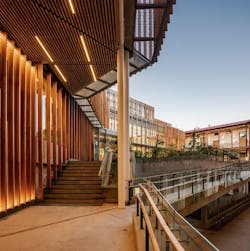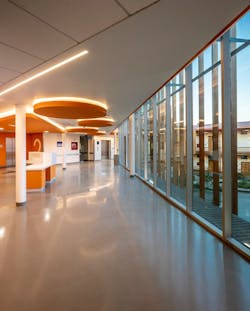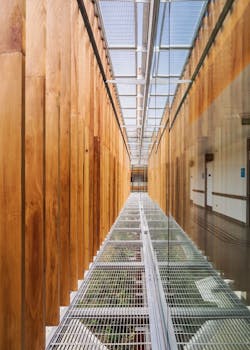“The city that takes good care of its cultural heritage is the city that listens to its past without neglecting its future.”
This conviction is one held and expressed by Luis Vidal, president and founding partner at international architecture firm luis vidal + architects, whose firm of his namesake was recently honored as a winner at the prestigious 2021 “Rethinking the Future” Awards for its design of the Matta Sur Community Center + CESFAM health clinic in Santiago, Chile. Respect for the past, present and future of the community was a cornerstone of the Matta Sur Complex.
The project consists of two buildings located within the same plot. The former Metropolitan Lyceum of Santiago, built in 1891, was restored to house a variety of public events, and includes an auditorium, a gymnasium, a nursery and kitchens for hosting cooking workshops. The second component is a new-build construction that accommodates CESFAM, a public primary healthcare center.
“Our design aimed to translate the most singular elements of the preexisting building by using a contemporary, austere language that does not compete with the historic building style, but enhances it,” Vidal said. “A mix of old and new elements define the development. The new facade design follows the criteria established by the existing facades, but it re-interprets the language from an architectural composition and technological point of view.”
[Related: How the Space Needle’s New Observation Deck Celebrates Its Original Design]
Después de un análisis exhaustivo del edificio preexistente, Luis Vidal + Architects propuso un extenso plan de renovación para el edificio escolar de 59,000 pies cuadrados. Durante un terremoto de magnitud 8,8 en 2010, el edificio de tres pisos sufrió daños importantes. Vidal dijo que había grietas en toda la estructura y daños en las paredes y vigas interiores. El tejado también sufrió daños importantes. Además, el robo, el vandalismo y la falta de entrevista dejó el edificio en muy mal estado y lo hizo inhabitable.
El equipo de diseño limpió y pintó las fachadas de hormigón, reemplazó las baldosas del suelo e instaló nuevas barandillas de madera. La firma tuvo mucho cuidado en preservar los elementos distintivos del edificio, como los pasillos al aire libre que recorren el alzado interior que da al patio.
“Sustainability remains critical,” Vidal noted. “The design of Matta Sur supposes the union of the past, present and future in a way that combines modernity and tradition, technology and sustainability through elements such as wood and light. Even the careful placement of windows—and the way they introduce natural light—can limit the amount of solar radiation exposure that the space needs, drastically reducing energy consumption and the electricity bill.”
In certain stairwells and consultation rooms, the design team incorporated patios to bring in natural light. Sedum-filled planters help reduce heat on the rooftop.
In addition to the buildings, the project included a central public plaza that provides the community with an open space to gather—a design element that’s been deemed the heart of the structure. The multipurpose complex, designed to combine modernity and tradition, will be utilized by approximately 30,000 people each year.
The project was developed for the Municipality of Santiago as part of its commitment to the rescue and validation of abandoned heritage buildings for cultural and neighborhood use. It stands as a beacon to the power of design to honor the past while embracing the future.

“Practicante de la cultura pop de toda la vida. Creador. Experto en zombis. Especialista en viajes en general. Friki de la televisión”.










